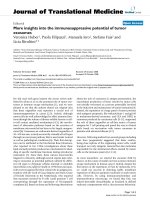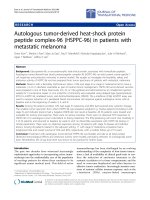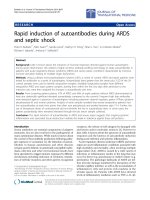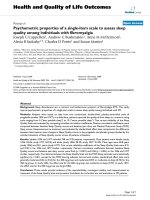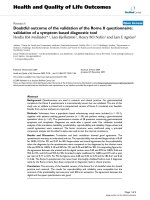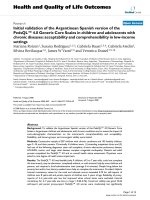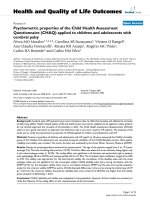báo cáo hóa học:" Psychometric validation of the Dutch translation of the quality of life in reflux and dyspepsia (QOLRAD) questionnaire in patients with gastroesophageal reflux disease" ppt
Bạn đang xem bản rút gọn của tài liệu. Xem và tải ngay bản đầy đủ của tài liệu tại đây (372.39 KB, 8 trang )
RESEARC H Open Access
Psychometric validation of the Dutch translation
of the quality of life in reflux and dyspepsia
(QOLRAD) questionnaire in patients with
gastroesophageal reflux disease
Leopold GJB Engels
1
, Elly C Klinkenberg-Knol
2
, Jonas Carlsson
3
, Katarina Halling
3,4,5*
Abstract
Background: The Quality of Life in Reflux and Dyspepsia (QOLRAD) questionnaire is one of the best-characterized
disease-specific instruments that captures health-related problems and symptom-patterns in patients with
gastroesophageal reflux disease (GERD). This paper reports the psychometric validation of a Dutch transla tion of
the QOLRAD questionnaire in gastroenterology outpatients with GERD.
Methods: Patients completed the QOLRAD questionnaire at visit 1 (baseline), visit 2 (after 2, 4 or 8 weeks of acute
treatment with esomeprazole 40 mg once daily), and visit 4 (after 6 months with on-demand esomeprazole 40 mg
once daily or continuous esomeprazole 20 mg once daily). Symptoms were assessed at each visit, and patient
satisfaction was assessed at visits 2 and 4.
Results: Of the 1166 patients entered in the study, 97.3% had moderate or severe heartburn and 55.5% had
moderate or severe regurgitation at baseline. At visit 2, symptoms of heartburn and regurgitation were mild or
absent in 96.7% and 97.7%, respectively, and 95.3% of patients reported being satisfied with the treatment. The
internal consistency and reliability of the QOLRAD questionnaire (range: 0.83-0.92) supported construct validity.
Convergent validity was moderate to low. Known-groups validity was confirmed by a negative correlation between
the QOLRAD score and clinician-assessed severity of GERD symptoms. Effect sizes (1.15-1.93) and standardized
response means (1.17-1.86) showed good responsiveness to change. GERD symptoms had a negative impact on
patients’ lives.
Conclusions: The psychometric characteristics of the Dutch translation of the QOLRAD questionnaire were found
to be satisfactory, with good reliability and responsiveness to change, although convergent validity was at best
moderate.
Background
Gastroesophageal reflux disease (GERD) is a condition
that develops when the reflux of stomach contents
causes troublesome symptoms and/or complications [1].
The characteristic symptoms of GERD are heartburn
and regurgitation, which have a prevalence of 75-98%
and 48-91%, respectively, in patients with reflux disease
[1]. Dysphagia is also common, especially in individuals
with reflux esophagitis [2]. GERD affects many aspects
of day-to-day functioning, including sleep, productivity
at work and at home, and enjoyment of meals and social
occasions [3-5]. Symptoms can also cause emotional
distress.
Assessing the imp act of reflux symptoms on patients’
lives can provide important information on health status
and perceived treatment efficacy. Such assessment
should be carried out using validat ed patient-reported
outcome instruments. In its draft guidance, the US Food
and Drug Adm inistratio n (FDA) encourages the devel-
opment of instruments that are able to translate a
change in symptoms into specific endpoints such as
* Correspondence:
3
Outcomes Research, AstraZeneca R&D, 431 83 Mölndal, Sweden
Full list of author information is available at the end of the article
Engels et al. Health and Quality of Life Outcomes 2010, 8:85
/>© 2010 Engels et al ; licensee BioMed Central Ltd. This is an Open Access article distributed under the terms of the Creative Co mmons
Attribution License ( which permits unrestricted use, distribution, and rep roduction in
any medium, provided the original work is properly cited.
improvements in the ability to perform daily activities or
improvements in psychological state [6]. The FDA eval-
uates such instruments by their ability to measure speci-
fic concepts in a relia ble and valid way. It also stipulates
that each instrument needs to be specific to the
intended population and to the characteristics of the
condition or disease treated.
Generic instruments capture a wide range of health-
related problems and allow for comparisons across dif-
ferent diseases. In contrast, disease-specific instruments
capture health-related problems and symptom patterns
that are of particular relevance to a specific condition
[7,8]. Disease-specific instruments are generally more
responsive than generic instruments in detecting s mall
changes over time, and are thus better suited as out-
come measures in interventional studies [7,8].
One of the best-characterized disease-specific instru-
ments for pat ients with GERD is the Quality of Life in
Reflux and Dyspepsia (QOLRAD) questionnaire [9]. The
QOLRAD questionnaire measures the impact of reflux
symptoms on patients’ emotional health, sleep, vitality,
eating and drinking, and physical and social func tioning.
The QOLRAD que stionnaire was originally developed in
US English, and has subsequently been translated and
culturally adapted for use in international studies
[10-12]. This paper reports the psychometric validation
of a Dutch translation of the QOLRAD questionnaire in
patients with GERD.
Methods
Patients
Patients with GERD were selected in gastroenterology
outpatient clinics. Inclusion criteria required a history of
heartburn of at least 3 months, and episodes o f heart-
burn of at least moderate severity for 3 days or more
during the 7 days prior to the study. Heartburn was
defined as a burning feeling, rising from the stomach or
lower part of the chest up towards the neck. The follow-
ing exclusion criteria wer e applied: the presence of
reflux esophagitis g rade C or D, presence or history of
other gastrointestinal diseases a nd conditions, and pre-
sence or history of other non-gastrointestinal serious
diseases and c onditions. Patients treated with proton
pump inhibitors or prokinetic drugs during the 14 days
preceding endoscopy or who had been treated with
non-steroidal anti-inflammatory drugs or Helicobacter
pylori eradication therapy were also excluded.
Patients received acute treatment for their symptoms
with esomeprazole 40 mg once daily for 2, 4 or 8 weeks.
The length of acute treatment was dependent on the
length of time taken to achieve sufficient symptom relief
and patient satisfaction. Patients satisfied with the treat-
ment and with sufficient symptom relief entered
the maintenance phase and were randomized to receive
on-demand esomeprazole 40 mg once a day or continu-
ous esomeprazole 20 mg once daily for 6 months. Data
are presented from visit 1 (baseline), visit 2 (after 2, 4 or
8 weeks of acute treatment with esomeprazole 40 mg),
and visit 4 (after 6 months of maintenance treatment)
[13].
The study was performed in accordance with the ethi-
cal principles of the Declaration of Helsinki, the Good
Clinical Practice and the Wet Medisch-Wetenschappe-
lijk Onderzoek met mensen (WMO). The final study
protocol, including the final version of the Patient Infor-
mation and Consent Forms, were approved in accor-
dancewiththeWMObyanIndependentEthics
Committee belonging to the Maasland Hospital, Sittard,
the Netherlands.
Symptom assessment
Investigators recorded patient demographics (including
sex, age, height and weight), medical history (including
history of reflux symptoms), and drugs used during the
month before e nrolment. Patients completed the QOL-
RAD questionnaire at each visit. All patients who pre-
maturely discontinued the study were encouraged to
complete the QOLRAD questionnaire at their last visit
to the clinic.
At each visit, investigators assessed the severity of
patients’ heartburn, regurgitation and dysphagia in the 7
days prior to the visit. Symptoms were scored as follows:
none (no complaints), mild (aware of symptom, but
easily tolerated), moderate (di scomforting symptom, suf-
ficient to cause interference with normal daily activities
and/or sleep), severe (incapacitati ng symptom, with
inability to perform normal daily activities and/or sleep).
Patients completed a daily paper diary during the study
treatment period, in which they recorded heartburn
severity during the past 24 hours. Patient satisfaction
was evaluated at visit 2 and visit 4, using a 4-poi nt
Likert scale (completely satisfied, quite satisfied, quite
dissatisfied, completely dissatisfied).
QOLRAD questionnaire
The heartburn version of the QOLRAD questionnaire is
a diseas e-speci fic quality of life instrument that includes
25 items combined into five domains: Emotional dis-
tress, Sleep disturbance, Food/drink problems, Physical/
social functioning and Vitality. Questions are rated on a
7-point Likert scale; the lower the value the more severe
the impact on daily functioning [9]. Previous studies
have shown that a difference of approximately 0.5 points
repre sents a cli nically relevant change [4,10]. The QOL-
RAD questionnai re has been vali dated in Australia,
Canada (French- and English-speaking regions), USA,
UK,Germany,Italy,Spain,Hungary,PolandandSouth
Africa [9-12,14,15]. The Dutch versio n of the QOLRAD
Engels et al. Health and Quality of Life Outcomes 2010, 8:85
/>Page 2 of 8
questionnaire was developed from the English version
by forward-back translation.
Psychometric evaluation
Reliability
Internal consistency refers to the extent to which the
items within each domain are interrelated. Cronbach’ s
a coefficient is the most widely used method of asses-
sing internal consistency; a high a coefficient (≥ 0.70)
suggests good internal consistency and reliability [16].
Ceiling effects (the proportion of patients having the
maximum score) were also assessed. The presence of
ceiling effects, in which a high proportion of the patients
gradethemselvesashavingthemaximumscore,indi-
cates that the scales will have poor discrimination. Thus
sensitivity and responsiveness is reduced.
Construct validity
Construct validity assesses whether an indicator actually
measures its underlying attr ibute. The construct validity
was examined by convergent and known-groups validity.
Convergent validity demonstrates whether a postu-
lated instrument domain correlates appreciably with all
other domains that should be related to it. Pearson’ s
product moment correlation was used to compare the
results of the QOLRAD questionnaire with clinician
assessments of reflux symp toms. Similar domains in
these instruments were expected to have high correla-
tions with each other. A strong correlation was consid-
ered to be over 0.60, a moderate correlation between
0.30 and 0.60, and a low correlation below 0.30 [17].
Low correlations were expected between those dimen-
sions that are theoretically unrelated constructs, thereby
testing the discriminant validity.
Known-groups validity consists of showing that an
instrument can differentiate between groups of patients
whose health status differs according to the ch aracteris-
tics of the patients’ disease, in this case clinician-rated
severity of GERD symptoms.
Responsiveness to change
Responsiveness to change was assessed using effect size
and standardized response mean. The effect size anchors
the c hanges against the variability in t he sample, and is
calculated by dividing the mean change by the standard
deviation at baseline. The standardized response mean
preserves the re lation to a statistica l test, a nd is ca lcu-
lated by dividing the mean change by the standard
deviation of the change. According to Cohen’ s defini-
tion, an effect size ≥ 0.8 indicates a large responsi veness
to change [18].
Statistical methods
Data entry took place in an Oracle-based clinical data-
base. Statistical analyses and computerized data checks
were performed using Statistical Analysis System (SAS,
version 8.02; Cary, 2001). The QOLRAD questionnaire
wasanalysedasmeanscoreperdomain.Ifdatawere
missing from one or more item, the mean of the com-
pleted items in the same domain was used, provided
that more than half of the items in that domain had
been completed.
Results
Demographic and clinical characteristics
A total of 1166 patients were entered in the study (visit
1). Of these, 1033 ( 88.6%) took part in visit 2 and 957
(82.1%) took part in visit 4. The reasons for drop-out
were withdrawal, loss to follow up and failure to fulfil
eligibility criteria. The mean age w as 49.1 years (stan-
dard deviation [SD]: 13.5) at visit 1, 49.3 years (SD:
13.4) at visit 2, and 49.3 years (SD: 13.3) at visit 4.
Patient demographics and clinical data are summarized
in Table 1.
Table 1 Patient demographics and clinical data
Variables Visit 1
(N = 1166)
%
Visit 2
(N = 1033)
%
Visit 4
(N = 957)
%
Age (years)
18-29 9.1 8.6 8.5
30-39 18.8 18.3 18.3
40-49 22.7 22.9 23.0
50-59 27.0 27.5 28.2
≥ 60 22.4 22.7 22.0
Male 53.2 54.4 55.1
Caucasian 97.5 97.8 98.2
Heartburn
a
None 0.3 76.5 76.5
Mild 2.5 20.2 18.7
Moderate 67.2 2.5 4.3
Severe 30.1 0.8 0.4
Regurgitation
b
None 19.8 84.7 90.6
Mild 24.7 13.0 7.3
Moderate 37.4 1.8 1.8
Severe 18.1 0.5 0.1
Dysphagia
c
None 68.7 95.0 96.0
Mild 17.6 4.1 3.4
Moderate 10.4 0.7 0.3
Severe 3.3 0.1 0.0
Satisfaction
d
Completely satisfied - 71.2 79.1
Quite satisfied - 24.1 15.8
Quite dissatisfied - 3.9 3.8
Completely dissatisfied - 0.8 1.0
a
In the week before the visit; unknown for 0.1% of patients at visit 4.
b
In the week before the visit; unknown for 0.2% of patients at visit 4.
c
In the week before the vis it; unknown for 0.2% of patients at visits 2 and 4.
d
In the week before the visit; unknown for 0.3% of patients at visit 4.
Engels et al. Health and Quality of Life Outcomes 2010, 8:85
/>Page 3 of 8
All patients had a history of he artburn of at least
3 months, and the majority had episodes of hear tburn
of at least moderate severity on at least 3 days in the
week prior to the study (Table 1). As rated by the inves-
tigator at baseline, 97.3% of patients had moderate or
severe heartburn, 55.5% had moderate or severe regurgi-
tation, and 13.7% had moderate or severe dysphagia. At
visit 2, symptoms of heartburn, regurgitation and dys-
phagia were mild or absent in 96.7%, 97.7% and 99.1%
of patients, respectively. Furthermore, 78.1% of patients
reported having symptoms on at most one day a week.
At visit 2, 95.3% of patients reported being satisfied with
the way their reflux symptoms were treated.
Psychometric evaluation
Reliability
Cronbach’s a scores ranged from 0.83 (Vitality) to 0.92
(Emotional distress) at baseline, thus demonstrating
internal consistency (Table 2). High ceiling effects
(defined as > 30% of patients having the maximum
score, i.e. ‘ none of the time’ or ‘ none at all’ )were
observed in 5 of the 25 items of the QOLRAD question-
naire. Four of these were in the Physical/social function-
ing domain. They were ‘ kept you from doing things
with your family’ (40.1%), ‘ difficulty socializing with
family’ (39.1%), ‘unable to carry out daily activities’
(38.4%) and ‘ unable to carry out normal physical activ-
ities’ (34.8%). The fifth item with a high ceiling effect
was in the Emotional distress domain: ‘discouraged or
distressed’ (32.7%). No ceiling effects were observed in
the remaining 20 items of the QOLRAD questionnaire.
Construct validity
Pearson correlation coefficients w ere used t o assess th e
convergent validity. There was a negative co rrelation
between t he QOLRAD questionnaire and the clinician-
assessed GERD symptom variables across all domains
(Table 3). The QOLRAD domains of Sleep disturbance,
Food/drink problems, Physical/social functioning and
Vitality yielded the strongest correlation with c linician-
asse ssed severity of heartburn. The QOLRAD Sleep dis-
turbance domain also correlated with clinician-assessed
severity of regurgitation.
Known-groups validity was used to compare the QOL-
RAD domain scores with clinician-rated severity of
reflux symptoms (Figure 1). All domains of the QOL-
RAD questionnaire were able to differentiate between
groups of patients whose health status differed accord-
ing to clinician-rated severity of reflux symptoms.
Increasing symptom severity was associated with a wor-
sening impact on daily functioning (i.e. a lower QOL-
RAD score). QOLRAD domain score s negatively
correlated with increasing clinician-rated severity of
heartburn (Figure 1a) and regurgitation (Figure 1b).
Responsiveness to change
Responsiveness to change from visit 1 to visit 2 was
evaluated using effect sizes and standardized response
means (Table 4). Effect sizes and standardized response
means were h igh (ranging from 1.15 to 1.93 and from
1.17 to 1.86, respectively) indicating a large responsive-
ness to change [18].
Mean QOLRAD domain scores
Mean QOLRAD domain scores at baseline (visit 1), at
visit2andatvisit4areshowninFigure2.Itemswere
rated on a 7-point Likert scale, with lower values indi-
cating a more severe impact on daily functioning. At
baseline, GERD symptoms impacted most strongly on
Vitality (mean QOLRAD domain score: 3.9), followed by
Food/drink problems (4.1), Sleep disturbance (4.5),
Emotional distress ( 4.7) and Physica l/social functioning
(5.2). With treatment, mean QOLRAD domain scores
Table 2 Cronbach’s a for QOLRAD questionnaire domains
at visit 1 (baseline)
QOLRAD domains Cronbach’s a*
Emotional distress 0.92
Sleep disturbance 0.91
Food/drink problems 0.87
Physical/social functioning 0.85
Vitality 0.83
*A high a coefficient (≥ 0.70) suggests good internal consistency and
reliability [16].
QOLRAD, Quality of Life in Reflux and Dyspepsia.
Table 3 Correlation coefficients between QOLRAD questionnaire domains and reflux symptom variables at visit 1
(baseline)*
QOLRAD domain
GERD symptomvariable
†
Emotional distress Sleep disturbance Food/drink problems Physical/social functioning Vitality
Dysphagia -0.13 -0.24 -0.22 -0.19 -0.20
Heartburn -0.22 -0.35 -0.32 -0.32 -0.32
Regurgitation -0.20 -0.30 -0.28 -0.28 -0.27
Days with heartburn
last week
-0.02 -0.01 -0.07 -0.02 -0.05
*A strong correlation was considered to be over 0.60, a moderate correlation between 0.30 and 0.60, and a low correlation below 0.30 [17].
†
As assessed by the clinician.
GERD, gastroesophageal reflux disease; QOLRAD, Quality of Life in Reflux and Dyspepsia.
Engels et al. Health and Quality of Life Outcomes 2010, 8:85
/>Page 4 of 8
increased by between 1.5 points (Physical/Social func-
tioning) and 2.5 points (Vitality), i ndicating a clinically
relevant improvement in patients’ daily functioning.
Discussion
The primary aim of this paper was to establish the psy-
chometric characteristics of the Dutch translat ion of the
QOLRAD questionnaire. The reliability of the translated
questionnaire was assessed using internal consistency.
All domains of the QOLRAD questionnaire demon-
strated internal consistency, with Cronbach’ s a score s
ranging from 0.83 to 0.92. Scores were thus well above
the 0.60 required to support construct validity [17].
These results are similar to those obtained for the
Figure 1 Quality of Life in Reflux and Dyspepsia (QOLRAD) questionnaire domain scores. Scores are stratified by clinician-rated severity of
a) heartburn and b) regurgitation at baseline (visit 1).
Engels et al. Health and Quality of Life Outcomes 2010, 8:85
/>Page 5 of 8
Italian [12], German [10], Spanish [14], Polish [15] and
Afrikaans [19] translations of t he QOLRAD question-
naire, for which the overall Cronb ach’ s a scores ranged
from 0.77 to 0.95. In the present study, high ceiling
effects were observed in five of the 25 QOLRAD
domains - four in the Physical/social functioning
domain and one in the Emotional distress domain. Sen-
sitivity and respo nsiveness to change is thus likely to be
reduced in these domains.
To assess construct validity, we used convergent valid-
ity and known-groups validi ty. Moderate correlations
were found between QOLRAD domains and clinician-
assessed severity of heartburn symptoms. Overall, c on-
vergent validity was moderate to low, and the highest
values were obtained for the heartburn and regurgitation
variables, these being the cardinal symptoms of GERD.
The higher correlation with heartburn and regurgitation
than with dysphagia may reflect that almost all patients
had heartburn and regurgitation at study entry, but
fewer than one-third had dysphagia. A ll domains o f the
QOLRAD questionnaire were able to differentiate
between groups of patients whose health status differed
according to clinician-rated severity of reflux sy mptoms,
thereby confirming the known-groups validity of the
instrument. Known-groups validity was si milarly con-
firmed in the Italian [12], German [10], Spanish [14],
Polish [15] and Afrikaans [19] translations of the QOL-
RADquestionnaire.Furthermore,QOLRADdomain
scores negatively correlated with increasing clinician-
rated severity of heartburn and regurgitation.
The responsiveness to change of the Dutch QOLRAD
questionnaire was tested using effect sizes and standar-
dized response means. According to Cohen’s definition,
an effect size ≥ 0.8 indicates a l arge responsiveness to
change [18]. Both the effect sizes and the s tandardized
response means of the QOLRAD questionnaire were
very high, ranging from 1.15 to 1.93, and from 1.17 to
1.86, respectively. The Dutch translation of the QOL-
RAD questionnaire thus displayed excellent responsive-
ness to change.
Reflux symptoms were seen to have a clear and con-
sistently negative impact on patients’ lives. QOLRAD
Table 4 Effect size and standardized response mean
QOLRAD questionnaire domains between visit 1 and
visit 2
QOLRAD domain Effect
size*
Standardized response
mean
Emotional distress 1.38 1.45
Sleep disturbance 1.40 1.41
Food/drink problems 1.93 1.86
Physical/social
functioning
1.15 1.17
Vitality 1.74 1.76
*An effect size ≥ 0.8 indicates a large responsiveness to change [18].
QOLRAD, Quality of Life in Reflux and Dyspepsia.
Figure 2 Mean Quality of Life in Reflux and Dyspepsia (QOLRAD) domain scores. Results are shown from visit 1 (baseline), visit 2 (after 2, 4
or 8 weeks of acid-suppressive treatment) and visit 4 (after 6 months of acid-suppressive treatment).
Engels et al. Health and Quality of Life Outcomes 2010, 8:85
/>Page 6 of 8
scores were lowest in the Vitality domain (mean QOL-
RAD score: 3.9), indicating that patients were feeling
tired or worn out, were generally unwell and had a lac k
of energy. Scores were also lowest in the Vitality domain
in the Italian [12] and Polish [15] translations of the
QOLRAD questionnaire (mean scores: 4.8 and 3.8,
respectively). Scores were also impaired in the Vitality
domain in the German [10], Spanish [14] and Afrikaans
[19] translations of the QOLRAD questionnaire (mean
scores: 4.4, 4.5 and 3.5, respectively), but were lowest in
the Food/drink problems domain in these populations
(mean scores: 4.4, 4.5 and 3.5, respectively), indicating
that, because of their symptoms, patients were restricted
in when or what they could eat and drink.
Virtually all patients reported moderate or severe
heartburn in the week prior to the study, and more than
half reported moderate or severe regurgitation. At visit
2, symptoms of heartburn and regurgitation were mild
or absent in almost all patients. Furthermore, mean
QOLRAD domain scores increased by between 1.5
points ( Physical/social functio ning) and 2.5 points
(Vitality). Previous studies have shown that a difference
in QOLRAD score of approximately 0.5 points repre-
sents a clinically relevant change [4,10]. The improve-
ments in QOLRAD scores observed in the current study
thus suggest a clinically relevant improvement in
patients’ daily functioning with acid-suppressive
treatment.
The study has two important limitations. Firstly, test-
retest reliability was not reported. Secondly, the study
was conducted in gastroen terology centres, and the
results are thus particular to patients referred for gastro-
enterological inve stigation. Thus, no conclusions can be
made as to whether the Dutch translation of the QOL-
RAD is consistent when measuring a stable variable on
two separate occasions, or whether its psychometric
characteristics would be equally good in different patient
populations with GERD.
Conclusions
The psychometric characteristics of the Dutch trans-
lation of the QOLRAD questionnaire were found t o
be good, with satisfactory reliability and validity, and
excellent responsiveness to change. In addition to the
original English-language version, several different
language versions of theQOLRADquestionnaire
have also been validated [9-12,19]. These, together
with the Dutch translation of the QOLRAD question-
naire, provide an excellent basis for collaborative
research between different parts of the world, and
make international trials more applicable, comparable
and generalizable despite differences in language and
culture.
Acknowledgements
We would like to thank Dr Anja Becher and Dr Christopher Winchester, from
Oxford PharmaGenesis™ Limited, who provided editorial assistance on behalf
of AstraZeneca. The study was funded by AstraZeneca, the Netherlands.
Author details
1
Department of Gastroenterology, Maasland Hospital, Sittard, the
Netherlands.
2
Department of Gastroenterology, VU Medical Centre,
Amsterdam, the Netherlands.
3
Outcomes Research, AstraZeneca R&D, 431 83
Mölndal, Sweden.
4
PRO consulting, Stora Åvägen 21, 436 34 Askim, Sweden.
5
Affiliation at the time the study was conducted.
Authors’ contributions
All authors contributed to the concept and design of the study, to the
interpretation of the data and to drafting the manuscript. JC performed the
statistical analysis. All authors read and approved the final manuscript.
Competing interests
Jonas Carlsson is an employee of AstraZeneca R&D Mölndal. Katarina Halling
was employed by AstraZeneca R&D Mölndal at the time the study was
conducted.
Received: 26 August 2009 Accepted: 17 August 2010
Published: 17 August 2010
References
1. Vakil N, Veldhuyzen van Zanten S, Kahrilas P, Dent J, Jones R: The Montreal
definition and classification of gastro-esophageal reflux disease (GERD) -
a global evidence-based consensus. Am J Gastroenterol 2006,
101:1900-1920.
2. Vakil NB, Traxler B, Levine D: Dysphagia in patients with erosive
esophagitis: prevalence, severity, and response to proton pump inhibitor
treatment. Clin Gastroenterol Hepatol 2004, 2:665-668.
3. Wiklund I: Review of the quality of life and burden of illness in
gastroesophageal reflux disease. Dig Dis 2004, 22:108-114.
4. Talley NJ, Fullerton S, Junghard O, Wiklund I: Quality of life in patients
with endoscopy-negative heartburn: reliability and sensitivity of disease-
specific instruments. Am J Gastroenterol 2001, 96:1998-2004.
5. Wahlqvist P, Karlsson M, Johnson D, Carlsson J, Bolge SC, Wallander MA:
Relationship between symptom load of gastroesophageal reflux disease
and health-related quality of life, work productivity, resource utilization
and concomitant diseases: survey of a US cohort. Aliment Pharmacol Ther
2008, 27:960-970.
6. Food and Drug Administration: Guidance for industry. Patient-reported
outcome measures: use in medical product development to support
labeling claims (draft guidance). [ />GuidanceComplianceRegulatoryInformation/Guidances/UCM071975.pdf].
7. Talley NJ, Wiklund I: Patient reported outcomes in gastroesophageal
reflux disease: an overview of available measures. Qual Life Res 2005,
14:21-33.
8. Wiklund I: Patient-reported outcomes. In GI Epidemiology. Edited by: Talley
N, Locke GR, Saito YA. Oxford: Blackwells; , 3 2007:24-29.
9. Wiklund IK, Junghard O, Grace E, Talley NJ, Kamm M, Veldhuyzen van
Zanten S, Paré P, Chiba N, Leddin DS, Bigard MA, Colin R, Schoenfeld P:
Quality of life in reflux and dyspepsia patients. psychometric
documentation of a new disease-specific questionnaire (QOLRAD). Eur J
Surg Suppl 1998, 583:41-49.
10. Kulich KR, Malfertheiner P, Madisch A, Labenz J, Bayerdörffer E, Miehlke S,
Carlsson J, Wiklund IK: Psychometric validation of the German translation
of the gastrointestinal symptom rating scale (GSRS) and quality of life in
reflux and dyspepsia (QOLRAD) questionnaire in patients with reflux
disease. Health Qual Life Outcomes 2003, 1:62.
11. Kulich KR, Wiklund I, Junghard O: Factor structure of the quality of life in
reflux and dyspepsia (QOLRAD) questionnaire evaluated in patients with
heartburn predominant reflux disease. Qual Life Res 2003, 12:699-708.
12. Kulich KR, Calabrese C, Pacini F, Vigneri S, Carlsson J, Wiklund IK:
Psychometric validation of the Italian translation of the gastrointestinal
symptom-rating scale and quality of life in reflux and dyspepsia
questionnaire in patients with gastro-oesophageal reflux disease. Clin
Drug Invest 2004, 24:205-215.
Engels et al. Health and Quality of Life Outcomes 2010, 8:85
/>Page 7 of 8
13. Engels L, Klinkenberg-Knol EC, Dekkers C, Beker JA, Tan TG, Timmerman RJ,
Haeck PWE: Esomeprazole continuous versus on demand maintenance
therapy in 1052 gastro-oesophageal reflux patients: similar satisfaction
but superior quality of life for once daily treatment. Gut 2003, 52(Suppl
VI):A130.
14. Kulich KR, Piqué JM, Vegazo O, Jiménez J, Zapardiel J, Carlsson J, Wiklund I:
[Psychometric validation of translation to Spanish of the gastrointestinal
symptoms rating scale (GSRS) and quality of life in reflux and dyspepsia
(QOLRAD) in patients with gastroesophageal reflux disease]. Revista
Clinica Espanola 2005, 205:588-595.
15. Kulich KR, Regula J, Stasiewicz J, Jasinski B, Carlsson J, Wiklund I:
[Psychometric validation of the Polish translation of the gastrointestinal
symptom rating scale (GSRS) and quality of life in reflux and dyspepsia
(QOLRAD) questionnaire in patients with reflux disease]. Pol Arch Med
Wewn 2005, 113:241-249.
16. Cronbach LJ: Coefficient alpha and the internal structure of tests.
Psychometrika 1951, 16:297-334.
17. Hinkle DE, Jurs SG, Wiersma W: Applied statistics for the behavioural
sciences. Boston: Houghton Mifflin, 2 1988.
18. Cohen J: Statistical power analysis for the behavioural sciences. New
York: Academy Press 1977.
19. van Rensburg CJ, Kulich KR, Carlsson J, Wiklund IK: Psychometric validation
of the Afrikaans translation of two patient-reported outcomes
instruments for reflux disease. S Afr Rev Gastroenterol 2006, 4:5-9.
doi:10.1186/1477-7525-8-85
Cite this article as: Engels et al.: Psychometric validation of the Dutch
translation of the quality of life in reflux and dyspepsia (QOLRAD)
questionnaire in patients with gastroesophageal reflux disease. Health
and Quality of Life Outcomes 2010 8:85.
Submit your next manuscript to BioMed Central
and take full advantage of:
• Convenient online submission
• Thorough peer review
• No space constraints or color figure charges
• Immediate publication on acceptance
• Inclusion in PubMed, CAS, Scopus and Google Scholar
• Research which is freely available for redistribution
Submit your manuscript at
www.biomedcentral.com/submit
Engels et al. Health and Quality of Life Outcomes 2010, 8:85
/>Page 8 of 8

